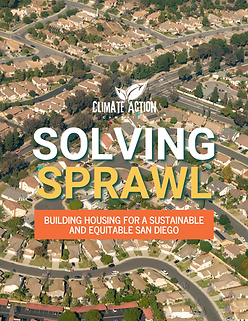
ABOUT THIS REPORT:
Decades of sprawl development have left our communities vulnerable to intense and more frequent wildfires and heatwaves, and locked families into mega-commutes, while doing little to solve our housing shortage.
Our new report outlines equitable alternatives to dangerous, expensive, and unsustainable sprawl development.
We’re facing an accelerated climate crisis that threatens the stability of our communities. We’re also facing a housing crisis and housing inequities. We can simultaneously choose both protecting the environment and providing affordable housing. We can help protect the people and places we love by stopping sprawl development and, instead, building affordable, infill housing near transit and jobs.
KEY FINDINGS:
These are the key problems found regarding sprawl and its impact on San Diego:
-
Sprawl is Unsustainable and Dangerous
-
Sprawl is Costly
-
Sprawl Exacerbates Economic and Racial Inequality
-
Sprawl is Unhealthy and Destructive

REPORT RECOMMENDATIONS:
-
Build More Homes in Existing Cities: This can be done through better planning, more diverse housing permits, funding affordable housing, leveraging public lands, and exploring social housing.
-
Invest in Existing Communities and Prevent Displacement: Local governments must intentionally protect vulnerable communities by expanding existing programs and preserving existing affordable housing, empowering community ownership and tenants, and exploring rent control and stabilization policies.
-
Promote Equity, Justice, and Health: Strategies include supporting home ownership for people of color, committing to robust community engagement, ensuring everyone lives in a healthy and climate resilient home, promoting environmental justice, and creating good jobs for all.







